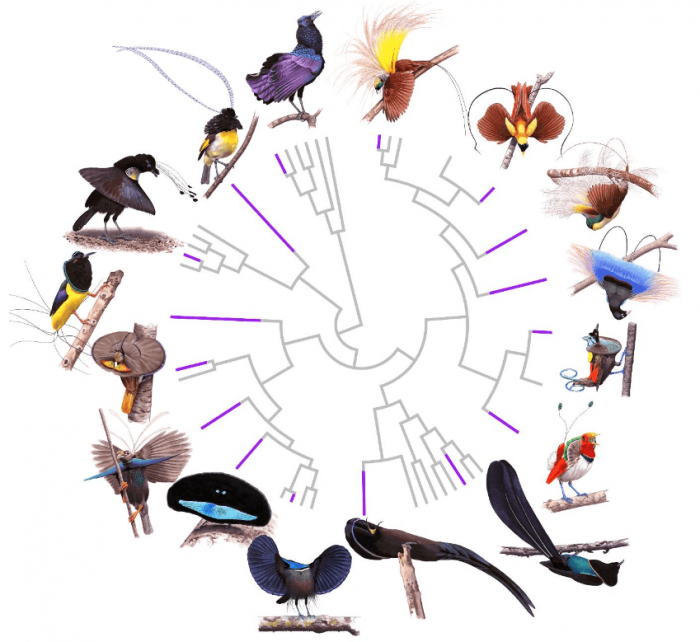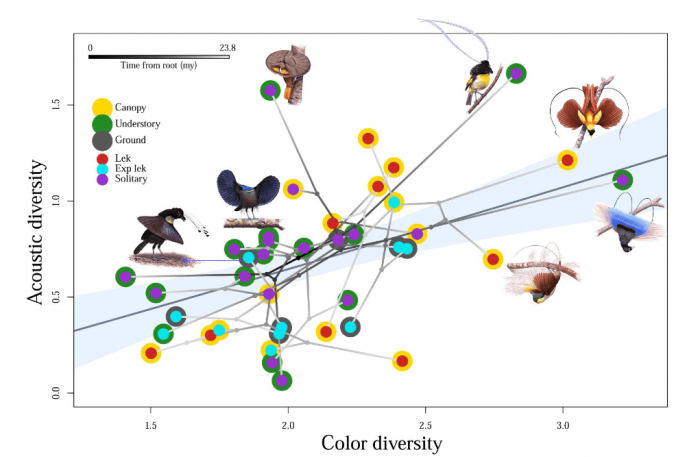
The birds-of-paradise are a charismatic, colorful family of birds found primarily on the island of New Guinea. The elaborate plumage of many species from this family have been incorporated into the adornments of the peoples of New Guinea for millennia, and a brief inspection of the ornamental variation across this avian family (Figure 1) provides an obvious answer as to why.

Figure 1. Diversity in color and display behavior among the birds-of-paradise (adapted from Ligon et al. 2018; original artwork by Szabolcs Kókay). The web-like lines in the center of the image illustrate the evolutionary relationships between species (similar to a family tree) and each of the representative species is highlighted in purple. Image republished with permission from Russell Ligon.
There is no doubt that the birds-of-paradise are incredibly beautiful, but why are they so beautifully different from one another? Likewise, why are the behavioral displays as seemingly dissimilar as breakdancing is to waltzing? Are there connections between colorful ornamentation and the behaviors they use to attract females? What about sound? Answering these important questions might provide new insights into the processes that promote diversification and the processes that have generated the incredible biodiversity we see on planet Earth.
We tackled these questions by leveraging the massive amounts of information contained in museum collections. In addition to the beautiful displays of animals, plants, and fossils you might see when you visit a natural history museum, these museums typically have enormous behind-the-scenes collections of biological material used by scientists for careful, rigorous studies. For our work, we studied specimens of birds-of-paradise collected over the last 150 years – carefully cataloged, stored, and maintained at the American Museum of Natural History (AMNH). Similarly, we used media collections (video, audio) stored in the Macaulay Library at the Cornell Lab of Ornithology to study the behaviors of live birds-of-paradise in the wild. In both cases, the data we collected from the museum “specimens” was only possible as a result of the painstaking, arduous, time-consuming, and herculean efforts of the naturalists and biologists who made the original collections.
Using data from the live-bird recordings collected as part of the long-term Birds-of-Paradise Project, as well as data from the preserved specimens at the AMNH, we uncovered fascinating links between colorful plumage and acoustic ornamentation across the family. Specifically, we found that species with more colorful, complex plumage ornaments also showed increasingly complex acoustics (Figure 2). Likewise, we found that species with complicated dances also exhibited more diverse sounds. These correlations suggest that female birds-of-paradise, who are the ones deciding which traits are sufficiently attractive to warrant mating, have chosen traits that are tightly interconnected in terms of complexity. The idea that bird-of-paradise females select mates based on correlated, multicomponent suites of ornaments is similar to the means by which humans evaluate complicated dance performances – we evaluate the essence of the work, the colors, the music, and the athleticism and grace of the performers – which is more than the simple sum of its parts.

Figure 2. Across birds-of-paradise, more colorful species also produce more complex vocal signals (adapted from Ligon et al. 2018; original artwork by Szabolcs Kókay). In this figure, each circle corresponds to a species, and its location reflects that species’ color and acoustic ornamentation. Additionally, species are connected by lines indicating their evolutionary relationships, and these lines are gray-scaled mapped to age (where darker branches occurred further back in time). Each point also contains information about that species’ display strategy, namely where they display (ground, understory, canopy) and with whom (solitarily, in a system where males are spaced out – exploded lek, or where males display in tight aggregations – called a lek). Image republished with permission from Russell Ligon.
The finding that male birds-of-paradise have similar complexity across multiple categories of ornaments is fascinating – this pattern is opposite the predictions of foundational biological thinkers Charles Darwin and Alfred Russel Wallace. These scientists made the observation that many species are either vibrantly colored or in possession of elaborate songs… but typically no species can “have it all.” The trade-off between song and color, which has been found in numerous biological systems, is thought to reflect a limited pool of resources available to invest in ornamentation OR the fact that such ornaments often make individuals more conspicuous to predators.
So what is going on with birds-of-paradise, given that they do not show signs of such a trade-off? Almost all birds-of-paradise live in New Guinea, an island with few mammalian competitors for fruits and seeds, and – collectively – these birds are perhaps the most important seed-dispersers for fruiting trees on this island (see Beehler 1992). The degree to which fruiting trees depend on birds-of-paradise has likely shaped the nutrient composition of the fruits themselves, turning them into ideal bird food that enables these birds to get maximum energy and nutrition. With their energetic needs met, the birds-of-paradise have more time to spend at display sites, either attempting to attract females or evaluating the efforts of multiple males trying their best to impress any female that wanders by.
Rather than being a phenomenon that is unique to birds-of-paradise, however, we think our findings actually speak to the broader phenomenon where females can make the most informed decisions about their mates be evaluating multiple traits in concert. In most systems, however, the other challenges of life (limited food, high predation risk, etc.) make it difficult for any given individual to express all ornaments at high levels. Consequently, the strength and direction of the correlations between different ornament types found across species may provide information about the relative strength of sexual selection (favoring those traits that increase the reproductive success of an individual) relative to ecological selection (favoring traits that increase longevity) across a diversity of systems and species.
These findings are described in the article entitled Evolution of correlated complexity in the radically different courtship signals of birds-of-paradise, recently published in the journal PLOS Biology.
CITATIONS & ADDITIONAL READING
- Beehler BM. 1992. Patterns of frugivory and the evolution of birds of paradise. In Acta XIX Congressus Internationalis Ornithologica, (ed. H Ouellet), pp. 816-828. University of Ottawa Press, Ottawa.
- Frith CB, Beehler BM. The birds of paradise: Paradisaeidae. Oxford: Oxford University Press; 1998.









